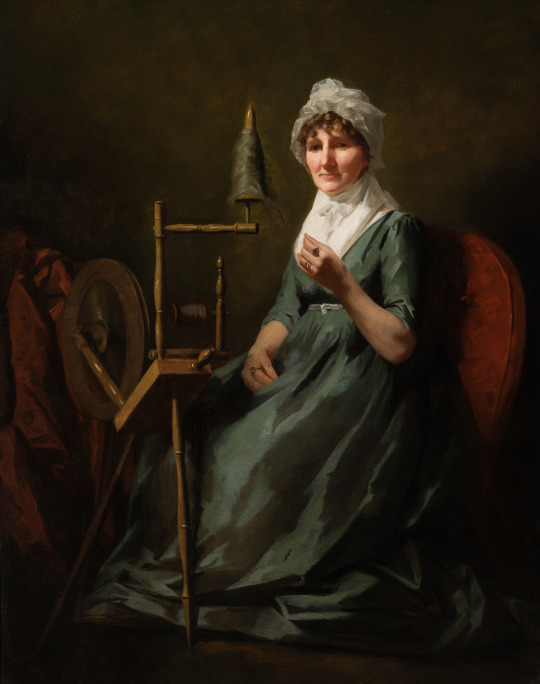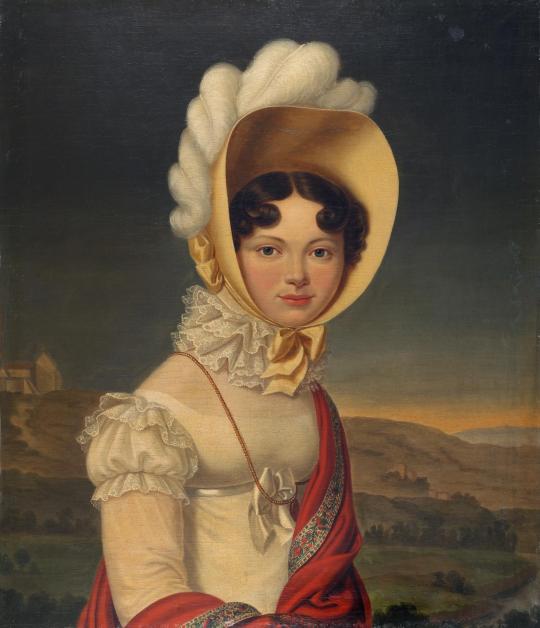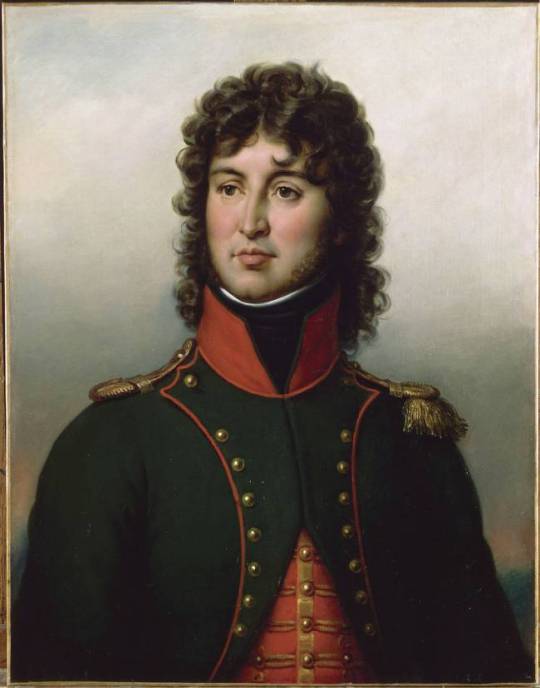#Jean-Baptiste-Paulin Guérin
Text

François-Athanase de Charette de La Contrie by Jean-Baptiste Paulin Guérin
#franćois athanase de charette#portrait#art#war in the vendée#nobleman#royalist#royalists#france#brittany#breton#french#french revolution#french revolutionary wars#jean baptiste paulin guérin#history#gentleman#vendéan#the terror#the reign of terror#europe#european#catholic and royal army of vendée#kingdom of france#aristocrat#general#monarchy#nobility#christianity#rebellion#king of the vendée
37 notes
·
View notes
Photo

1816 Jean-Baptiste-Paulin Guérin - Portrait of a woman, three-quarter length, in an elegant black velvet dress with lace trim, seated in an Empire chair on a red embroidered shawl on a terrace
(Private collection via Sotheby’s)
306 notes
·
View notes
Photo






1810s dress -
Top: Lady Hilgrove Turner by ? (Jersey Museum and Art Gallery - St Helier, Jersey, UK). From artuk.org 959X1200 @72 198kj.
Second row left: 1810 Mrs. Margaret Mair by Henry Raeburn (University of Louisville, Speed Art Museum - Louisville, Kentucky, USA). From tumblr.com/blog/view/lavenderiscalming 1184X1500 @72 406kj.
Second row right: 1815 Agalé-Constance Boudard by Adèle Romany (location ?). From tumblr.com/blog/view/lenkaastrelenkaa/693273842257395712
Third row: 1816 Woman, three-quarter length, in an elegant black velvet dress with lace trim by Jean-Baptiste-Paulin Guérin (Sotheby's - 27Jan22 auction Lot 51). Erased spots w Pshp 1538X2000 @300 772kj.
Fourth row: 1816 Ekaterina Pavlovna, future Queen of Württemberg by Henri-François Riesener (Tver Regional Art Gallery - Tver, Tver Oblast, Russia). From tumblr.com/blog/view/history-of-fashion 1719X2000 @72 654kj.
Fifth row: 1819 Rosalia Klieber by Carl Peter Goebel the Elder (Belvedere - Wien, Austria). From tumblr.com/blog/view/costumedufilm; erased cracks & spots w Pshop 2048X2581 @72 1.3Mj. Skirts are no longer free flowing muslin.
#1810s fashion#Empire fashion#late Georgian fashion#Lady Hilgrove Turner#curly hair#square neckline#quarter-length full sleeves#Empire waistline#close skirt#Margaret Mair#Henry Raeburn#cap#fichu#high neckline#Agalé-Constance Boudard#Adèle Romany#straight hair#tiara#modesty piece#wrap#Jean-Baptiste-Paulin Guérin#neckline ruff#Ekaterina Pavlovna#Henri-François Riesener#poke bonnet#feathered bonnet#fraise#long tight under-sleeves#Rosalia Klieber#Carl Peter Goebel the Elder
27 notes
·
View notes
Text

Jean-Baptiste-Paulin Guérin (1783-1855) - Portrait of a woman
3 notes
·
View notes
Photo

Paulin-Jean-Baptiste Guérin, Self-portrait, head and shoulders
2 notes
·
View notes
Text
Joachim Murat: his youth in Quercy.
His steps often joined those of Napoleon. Born 250 years ago in Labastide, Marshal of France, the king of Naples remained, all his life, attached to his native land. His native village now bears his name: Labastide-Murat.
Published on August 29, 17 at 16:05, in ActuLot

Joachim Murat en uniforme de sous-lieutenant au 12e Régiment de Chasseurs en 1792 (Age 25), by Jean-Baptiste Paulin Guérin, 1835
His name will later be inscribed on the Arc de Triomphe de l'Etoile. On April 5, 1791, three young people from Quercy (Murat, Bessieres and Ambert), appointed by the Lot Directory to be part of the King's constitutional guard, whose creation has just been voted by the Legislative Assembly, take the road to Paris. Coming from a family of small social status, Murat will reach the highest military glory thanks to the Republican wars and the prestigious imperial epic.
He was born on a causse with unexplored abysses
Joachim Murat was born on March 25, 1767, at La Bastide-Fortunière, a village in the Causse de Gramat. This physical environment has a certain connection with the future King of Naples' life and character. “La Bastide, a small village on the high plateau, looks like a fortress commanding the country. This majestic appearance amidst the drought, the almost desolation of the limestone soil which unexplored abysses hollow out in some places is the very image of Murat's life, a life full of contrasts where the good and the worst intertwine, where the peak honors and glory are next to disasters, mentions Marcel Dupont in his work on Murat. The sometimes violent wind is still a striking image of the marshal's mind, always filled with clouds and where hopes, vast projects, fury and annihilation collide day and night. Here is summarized in a few strokes, the prodigious and fatal destiny of this horseman who would have no equal to descend like a windstorm on the enemy troops.
His mother Jeanne's favorite child
Yet he seemed destined for a peaceful existence. Murat comes from a family that has lived in the town for more than three centuries. They are hard-working peasants, exploiting poor soil in harsh winters. How could a king arise from this modest environment more conducive to the development of country virtues than to warlike exploits?
This required the ardor of his youth, which will never leave him, but also the revolutionary upheaval. His father exploited the lands of "a few enlightened minds" in the village. Not being the owner, he is the manager, receiving earnings proportional to the crops. These are certainly satisfactory because the couple have a large house in the center of the town. This is the mother’s domain. The ground floor has been converted into an inn and the floor is divided between the family apartment and a few rooms for passing guests. This energetic woman who runs the inn is a caring mother. The good Jeanne Loubières, whom he will adore all his life, in fact, makes of the youngest of her eleven children, her favorite. By her constant presence, her desire to provide Joachim with an education, that goes beyond that of his environment, she will shape this son to the point that he will never forget his childhood.
With his curly hair and cheerful face, he's a rowdy kid, sometimes a brawler, as it should be to be respected in this country where endurance is proof of character. His time at La Bastide-Fortunière school made a good impression on his teachers: he is an average student but whose qualities of camaraderie and friendliness are recognized. His loving mother, who has deep religious feelings, thinks that the day will come when young Joachim will enter the Orders and may be parish priest of La Bastide.
His great pleasure is to lead alone the horses to the village trough. At the age when a horse seems formidable to a child, Joachim, who has an unusual vigor, already knows how to subdue them.
An amazing ability to lead
These predispositions did not arouse any suspicion among his parents who obtained a scholarship to send him, at 10 years old, to the Saint-Michel college in Cahors. He will stay there for 8 years. It is there that he will have as a comrade Jean Bessières from Prayssac, a future Marshal of the Empire. An unwavering friendship is born between these two men who would become close to the emperor.
Far from La Bastide, the young Murat discovers unknown horizons which open up new appetites for him. His intelligence is real. But as soon as he crosses the threshold of the class, he takes a singular ascendancy on his comrades, even develops an astonishing capacity to lead. How to blame him? If he goes too far for his age, he knows how to repent, implore and become very sweet again.
His whole life, he will use these weapons. Many contemporaries believe that he is completely sincere. Going from anger to tenderness, from elation to dejection, he is already and will remain, impulsive, even excessive in everything. Not without kindness and generosity.
At 20, he joins the cavalry
At the age of eighteen, he joins the Lazarists' seminar in Toulouse. But wearing the cassock does not make the seminarian. And this handsome young man of 1.85 meters, with a pleasant smile, already leads, outside the establishment, a private life the "good fathers" ignore. Here comes an important moment in Murat's life: his military engagement. It is allowed to think, with Jean Tulard, that after a quarrel, our too fiery seminarian was excluded from the University and dreading his father, takes advantage of the passage of the Cavalry of the Ardennes regiment to sign up for, he says "a life that does not displease him". In fact, the new Chasseur is "thrilled". He quickly stood out for his ability to train the most reticent horses and quickly became sergeant*.
For the simple rider, the days are repetitive and gruelling. After an early awakening (at six o'clock), you must groom sick animals, currycomb and brush them before preparing fodder, water and oats. It is only after this daily work, at ten o'clock that a soup is distributed. Then the upkeep chores of the stables. Strict rules still from the Ancien Régime! Because already Parisian ideas are swarming in the garrisons.
Giving free rein to his temperament, his need to be a leader, Murat, who places a lot of hope in the new ideas, takes the lead of the discontented men of the Regiment. This behavior is little appreciated by his leaders: he is put on permanent leave and expelled from the army. Humiliated, he decides to go back to the Lot. We are in 1789.
Delivery Clerk in Saint-Céré
Very badly received by his father who cuts him off, he returns to Saint-Céré where he is hired as a delivery clerk. For a few months, he was enraged, champing at the bit with impatience, convinced that his place is not here. The villages are buzzing. He became aware of the real state of France, of the mounting demands of the campaigns. Murat takes advantage of this return to his native land to attend and participate in public meetings of local clubs.
The past winter has been harsh and long. The harvest was poor. Lack of food and unemployment strike everywhere. Castles see their dovecote burned down. " Here will be hanged the first inhabitant who will pay the rent to the lord," says a poster from a Cahors merchant. It’s the revolt. Louis XVI summons the Etats Généraux on May 1, 1789 in Versailles. In 1790, for the Fête de la Fédération on July 14, each department must appoint two to three delegates. You can imagine that Murat is volunteering! The sympathetic, sweet talking but proud young man speaks. And it is in Lotois dialect that he expresses himself in cafes, wishing to reach the greatest number. The Revolution is born: Joachim Murat, who is part of the Third Estate by his origins, tries to change public opinion according to events. Every Sunday, he goes to Cahors: he listens, he harangues the crowd. He is on the Montfaucon list and is chosen to represent the Lot department.
The republican patriot leaves for Paris
Murat, 23, can go and explore the capital. It’s the consecration.
A new man is born. After a secular mass celebrated by former Bishop Talleyrand, speeches on the Champ de Mars ignite the crowds. One hundred thousand Parisians came to celebrate the first anniversary of the Capture of the Bastille. A year later, returning to the army, he is appointed to the King's Constitutional Guard, to protect but also to monitor Louis XVI. Indignant, the protester manifests a flawless patriotic commitment, calling himself a "pronounced republican", facing "this hideout of royalists who gravitate around the king". But the wind turns, Robespierre falls. His revolutionary passion almost interrupted his meteoric career. Bitter and worried, he is put on leave and returns for some time to Quercy, "wanting to become a simple plowman again".
Aide de camp
Skeptical about his future, then dejected, Murat quickly reacts, helped by the deputy for Gourdon, Jean-Baptiste Cavaignac, who encourages him to return to Paris. It is on the night of 12 to 13 Vendémiaire (October 5, 1795) that Murat is put in contact with the First Consul who needs him. He orders him to save the Convention threatened by the royalist riot. Forty cannons are placed by Squadron Leader Murat around the Tuileries Castle. Three hundred royalists will be killed. The government of the Republic is saved again. As Tulard points out: "From now on the star of Murat will merge with that of Bonaparte". No more depression, finally power and glory.
Promoted Bonaparte's aide-de-camp, he leaves for the Italian Campaign, direction Marengo. There, "his clothes will be riddled with bullets", but they will know victory.
He becomes Napoleon I's brother-in-law
In 1800, he marries Caroline, the First Consul's youngest sister, becoming the brother-in-law of the future Napoleon I. This marriage will give Murat an outstanding position among the marshals of the Empire. Quickly, he is invited to move to the Château des Tuileries and becomes part of the close entourage of the new master of France.
The rouser of men from the imperial epic will remain kind to his family at La Bastide. Coming from a small inn in Quercy to fly with his squadrons across Europe and into Egypt, Murat seems like a legendary character. Chateaubriand will devote long passages to him in the "Mémoires d'Outre Tombe". He will be admired by Stendhal, Dumas and Balzac. Three words characterize the King of Naples: ardor, ambition and panache. If he remains the most magnificent rouser of men the imperial epic will produce, he will invest much into the Lot whose deputy he will become in 1803.
And he will show kindness for his whole family. Especially for his mother, for whom he will show a deep attachment: he sends her rosaries blessed by the Pope.
The portrait he has done of Jeanne in 1792 will never leave him. It will be with him, in his homes, in his tent during his campaigns and in Naples, in his palace. He will build a castle for his "La Bastide family" in his native village, modeled on the Palais de l'Elysée, where he had resided as governor of Paris.
The King of Naples dies executed on October 13, 1815.
By André Décup
[Translation is mine.
Note: I translated by ‘sergeant’ the grade of Maréchal des Logis, which is its equivalent in the cavalry (and nowadays in the Gendarmerie).
There is no right translation for “entraîneur d’hommes”, I hope “rouser” doesn’t seem too weird in English.]
31 notes
·
View notes

